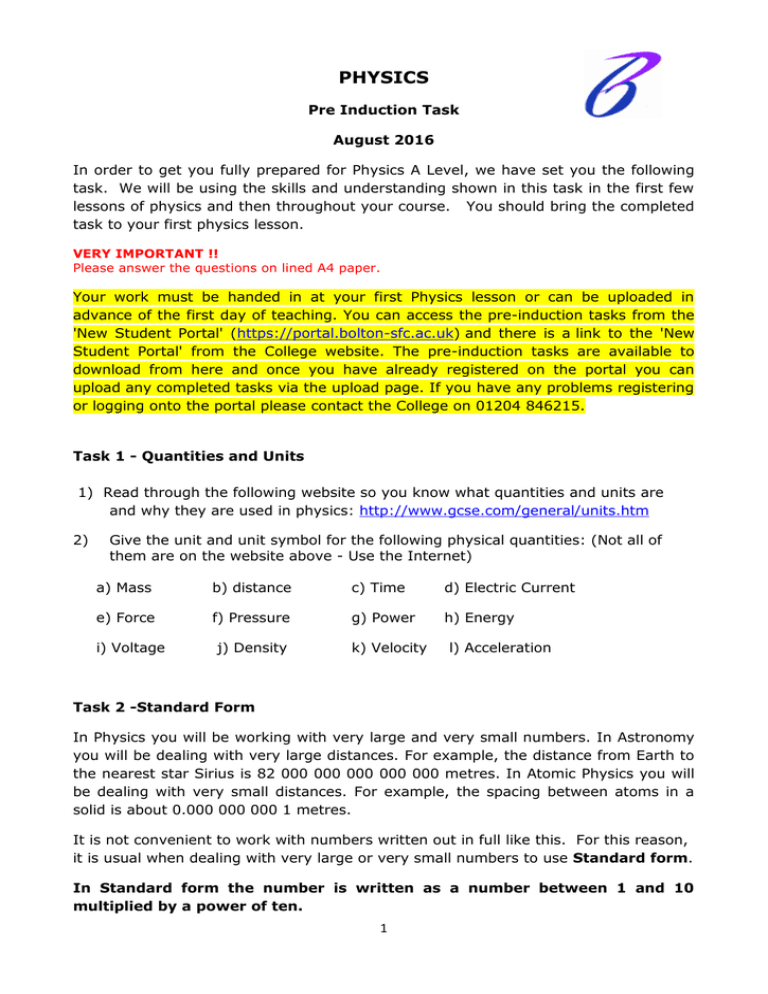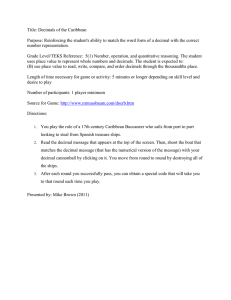physics - Bolton Sixth Form College
advertisement

PHYSICS Pre Induction Task August 2016 In order to get you fully prepared for Physics A Level, we have set you the following task. We will be using the skills and understanding shown in this task in the first few lessons of physics and then throughout your course. You should bring the completed task to your first physics lesson. VERY IMPORTANT !! Please answer the questions on lined A4 paper. Your work must be handed in at your first Physics lesson or can be uploaded in advance of the first day of teaching. You can access the pre-induction tasks from the 'New Student Portal' (https://portal.bolton-sfc.ac.uk) and there is a link to the 'New Student Portal' from the College website. The pre-induction tasks are available to download from here and once you have already registered on the portal you can upload any completed tasks via the upload page. If you have any problems registering or logging onto the portal please contact the College on 01204 846215. Task 1 - Quantities and Units 1) Read through the following website so you know what quantities and units are and why they are used in physics: http://www.gcse.com/general/units.htm 2) Give the unit and unit symbol for the following physical quantities: (Not all of them are on the website above - Use the Internet) a) Mass b) distance c) Time d) Electric Current e) Force f) Pressure g) Power h) Energy i) Voltage j) Density k) Velocity l) Acceleration Task 2 -Standard Form In Physics you will be working with very large and very small numbers. In Astronomy you will be dealing with very large distances. For example, the distance from Earth to the nearest star Sirius is 82 000 000 000 000 000 metres. In Atomic Physics you will be dealing with very small distances. For example, the spacing between atoms in a solid is about 0.000 000 000 1 metres. It is not convenient to work with numbers written out in full like this. For this reason, it is usual when dealing with very large or very small numbers to use Standard form. In Standard form the number is written as a number between 1 and 10 multiplied by a power of ten. 1 1.) Large Powers: Standard Form into Decimals e.g. Convert 5.0 x 106 into a decimal. The power of ten tells you how many places to move the decimal point to the right. 5.0 x 106 = 5000000.0 - the decimal point moves to the right 6 places Questions 1 Convert the following numbers in standard form into decimals: a.) 4.2 x 106 f.) 3.5 x 1011 b.) 5.6 x 103 c.) 2.2 x 105 d.) 1.8 x 108 e.) 5.2 x 102 g.) 7.2 x 109 h.) 1.1 x 101 2.) Large Powers: Decimals to Standard Form e.g. Convert 82 000 000 000 000 000 into standard form. Put the decimal point after the first number and count the number of places it needs to be moved to the right. 8.2 0 0 0 0 0 0 0 0 0 0 0 0 0 0 0 The decimal point moves to the right 16 places so it is 8.2 x 1016. Questions 2 Convert the following numbers in decimals into standard form: a) 3400 g) 430900 b) 120 c) 230000 h) 20540000 d) 1010000 e) 96000000 f) 12 3.) Small Powers: Standard Form into Decimals e.g. Convert 1.4 x 10-10 into a decimal. The power of ten tells you how many places to move the decimal point to the left. 1.4 x 10-10 = 0 .0 0 0 0 0 0 0 0 0 1 4 = the decimal point moves to the left 10 places Questions 3 Convert the following numbers in standard form into decimals: a) 4.2 x 10-5 b) 1.6 x 10-3 c) 7.2 x 10-1 d) 8.3 x 10-8 e) 5.2 x 10-7 f) 5.7 x 10-11 g) 7.2 x 10-2 2 4.) Small Powers: Decimals to Standard Form e.g. Convert 0.000005 into standard form Put the decimal point after the first number and count the number of places it needs to be moved to the left to make 0.000005. The number of places moved is the power. 0.0 0 0 0 0 5. It is moved 6 places to left so 5.0 x 10-6. Questions 4 Convert the following numbers in decimals into standard form: a)0.034 b) 0.00051 c) 0.28 f) 0.0012 g) 0.0000000809 d) 0.0000005 e) 0.00000000096 Task 3 – Unit Prefixes 1.) Read through the following website so you know what unit prefixes are and why they are used in physics: http://www.gcse.com/general/prefixes.htm 2.) Give the prefix name and symbol for the following: (e.g. 10-9 = nano = n) a) 103 b) 10-3 c) 106 (Use other Website for f) and g) d) 10-6 e) 109 f) 1012 g) 10-12 3.) You use prefix multipliers (http://www.gcse.com/general/prefixes.htm) to write units in full. e.g. 1.2 kW = 1.2 x 1000 W = 1200 W e.g. 10 mm = 10 x 1/1000 = 0.01 m Use prefix multipliers to write units in full. a) 10 MW b) 3 ms c) 25 GV d) 10 s e) 16 ns f) 8.6 km g) 100 mA h) 15 cm i) 560 Tm j) 1.3 nm into m 3 Task 4 Scalars and Vectors Using these definitions, divide these quantities into vectors and scalars. density electric charge electrical resistance energy field strength force friction frequency mass momentum power voltage volume weight work done Task 5 Adding Perpendicular Vectors 1.) Use the A Level Physics S-Cool Website http://www.s-cool.co.uk/alevel/physics to learn the technique to find the resultant vector. 2.) Solve these problems below on finding resultant vectors. 4 Task 6 – Resolving Vectors 1.) Use the A Level Physics S-Cool Website http://www.s-cool.co.uk/alevel/physics or The Physics Classroom http://www.physicsclassroom.com/class/vectors/Lesson-1/Vector-Resolution to learn the technique used when resolving vectors. 2.) Resolve the following vectors into Vertical and Horizontal Components. 5



